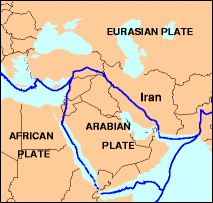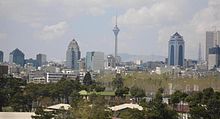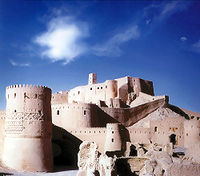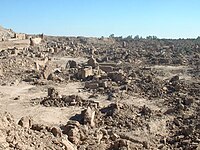2003 Bam earthquake
 Destruction in Bam | |
| UTC time | 2003-12-26 01:56:52 |
|---|---|
| ISC event | 7217667 |
| USGS-ANSS | ComCat |
| Local date | December 26, 2003 |
| Local time | 05:26 Iran Standard Time |
| Magnitude | 6.6 Mw[1] |
| Depth | 15 km (9.3 mi)[1] |
| Epicenter | 28°51′N 58°15′E / 28.85°N 58.25°E[1] |
| Type | Strike-slip |
| Areas affected | Iran |
| Max. intensity | MMI IX (Violent) [2] |
| Peak acceleration | 0.98 g [2] |
| Casualties | 34,000 dead[3][4] 200,000 injured[5][3] 45,000–75,600 displaced[5] |
An
Following the earthquake the U.S. offered direct humanitarian assistance to Iran and in return the state promised to comply with an agreement with the International Atomic Energy Agency which supports greater monitoring of its nuclear interests. In total a reported 44 countries sent in personnel to assist in relief operations and 60 countries offered assistance.
Following the earthquake, the Iranian government seriously considered moving the capital of Tehran in fear of an earthquake occurring there. The earthquake had a psychological impact on many of the victims for years afterwards. A new institutional framework in Iran was established to address problems of urban planning and to reconstruct the city of Bam in compliance with strict seismic regulations. This process marked a turning point, as government ministers and international organizations collaborated under this framework with local engineers and local people to organize the systematic rebuilding of the city.
Background
City of Bam

Before the earthquake, Bam had a population of roughly 97,000.
Iranian earthquake education
There is little earthquake education in Iran
Tectonics

The preliminary analysis of the pattern of seismic-waves radiating from December 26, 2003, earthquake was consistent with the earthquake having been caused by right-lateral strike-slip motion on a north-south oriented fault. The earthquake occurred in a region within which major north-south, right-lateral, strike-slip faults had been previously mapped, and the epicenter is near the previously mapped, north-south oriented Bam Fault. However, field investigations will be necessary to find if the earthquake occurred on the Bam Fault or on another. The Bam earthquake is 100 kilometres (62 mi) south of the destructive earthquakes of June 11, 1981 (magnitude 6.6, approximately 3,000 deaths) and July 28, 1981 (magnitude 7.3, approximately 1,500 deaths). These earthquakes were caused by a combination of reverse-motion and strike-slip motion on the north-south oriented Gowk fault.[11]
The rupture length of the earthquake was estimated to be around 24 kilometers. More than half of the quake was produced from its southern segment of approximately 13 kilometres (8 mi), where the slip reached a maximum of up to 270 centimetres (8.9 ft) resulting in a large stress drop of at least 6
Damage and casualties
The quake occurred at 01:56 UTC (5:26 AM Iran Standard Time) on December 26, 2003. Its epicenter was roughly 10 kilometres (6 mi) southwest of the ancient city of Bam. Maximum intensities were at Bam and Baravat, with the most damage concentrated within the 16 kilometres (10 mi) radius around the city.[13]

At least 26,271 people were killed and 30,000 injured. In terms of human loss the quake was the worst to occur in Iranian history.[13] The BBC reported that a large number of victims were crushed while sleeping.[8] Eleven-thousand students were killed and 1/5 of the 5,400 local teaching staff were also. This caused a significant problem for the local education system.
Up to ninety

One reason for the large number of casualties was that when the walls began to fall down, the heavy roofs would collapse, leaving few air pockets in them.[16] The dust and lack of oxygen contributed to the suffocation of survivors.[14] The Iranian government promised to prosecute anyone who violated building regulations, even setting up a special unit to deal with the issue.[19]
A study of 210 victims showed that on average, each person had spent 1.9 hours under destroyed buildings. Among the victims, approximately 19 had
The
Electricity and water supplies were cut by the earthquake.[8] At least 29 serious aftershocks struck Bam following the main shock.[21]
A large number of schools were affected by the tremor. An estimated 1,200 teachers and 10,000 students were killed. Ali Zang-Abadi, head of education in Bam, described the state of pupils and teachers as "badly need[ing] psychological help because they are morally devastated". Around January 5, teachers were being registered to resume educating.[22]
Response
Iran–United States relations
Relations between the United States and Iran thawed due to the earthquake. U.S.-Iranian relations had been tense during the early years of the George W. Bush. presidency, having reached a low after the "axis of evil" speech given by President George W. Bush.[18] However, following the earthquake, White House spokesman Scott McClellan spoke on behalf of President Bush: "Our thoughts and prayers are with those who were injured and with the families of those who were killed."[8]
The U.S. offered direct humanitarian assistance to Iran which was initially rejected but accepted later.[19] On December 30 an 81-member emergency response team was deployed to Iran via U.S. military aircraft which consisted of search and rescue squads, aid coordinators, and medical support[23] resulting in the first U.S. military airplanes to land in Iran for more than 20 years.[14] Sanctions were temporarily relieved to help the rescue effort.[22]
In return, Iran promised to comply with an agreement with the International Atomic Energy Agency which supported better monitoring of its nuclear interests. This led U.S. Secretary of State Colin Powell to suggest direct talks with Iran in the future,[18] however, he also said that the U.S. was still concerned about other Iranian issues such as the prospect of terrorism and the country's support of Hamas.[18]
Reaction to the help and rescue from the U.S. was mixed. It was well received by physicians and civilians at the scene, however, in contrast to this support,
Relief
Bam was described as "literally a rubble pile" by the U.S. relief coordinator, Bill Garvelink.
On January 8, the
The People's Republic of China was one of the first countries to supply aid. Upon hearing of the quake, it immediately sent a 43-member rescue squad. In total, its government donated 15 million yuan (US$1.81 million). Many individuals and companies also donated money and/or supplies.[28]

The 81-member emergency response team worked with an 11-member Fairfax County USAR Task Force (VA-TF1), 57 member International Medical/Surgical Response Team (IMSuRT), and a 6-member Management Support Team (MST) from the
From December 31 to January 4, the IMSuRT field hospital treated 727 patients, including surgeries and post-trauma cases of shock. The IMSuRT hospital closed on January 5, and from then on the
During the nights following the earthquake, the temperatures would drop to "bitterly cold" extremes, effectively killing some survivors.[14] Many of these individuals were living in unheated tents among the rubble which forced the coordinators to move thousands of families to heated[24] camps on the outskirts of Bam. Unfortunately, this action was met with some resistance and resulted in many residents to stay in place.[22] The Iranian government was, conversely, criticized for not supplying enough tents. Those that owned motorized vehicles were met with jammed traffic going both ways through Bam. Survivors loaded their belongings to move elsewhere while relief supplies, volunteers, and relatives were arriving.[16] In some areas, looters stole food from warehouses and local markets, causing the police force to react to stop further destabilization of the rescue efforts.[16]
On December 29, a baby girl named Nassin was discovered alive under the rubble in her deceased mother's arms. China Daily called it "a rare moment of joy amid the devastation of Iran's worst earthquake for years."[29] Around this time, relief operations had begun to shift from finding survivors to caring for them. Rescue workers began to slow their efforts, although three individuals were discovered alive shortly after. Water and electricity were restored to most parts of the city by then as well.[26]
One of the most notable rescues was that of 97-year-old Sharbānou Māzandarānī (شهربانو مازندرانی in Persian), who was trapped in her home for eight days until she was rescued unhurt on January 3. Rescue workers took three hours to dig her out after sniffer dogs found her.[30] Renewed media interest came to Bam on January 8, when a man was pulled out of the rubble alive. The chances of finding more living survivors following this were reportedly very slim.[31]
An Iranian navy helicopter crashed 30 miles (48 km) southwest of Bam on December 28 after making a delivery of tents and blankets.[16] It was headed toward Bandar Abbas as it went down for unknown reasons. On deck were two pilots and a third person, none of whom survived. The helicopter was one of more than 500 who delivered aid to the Bam region.[32]
Aftermath

After the earthquake, the Iranian government considered moving the state capital from Tehran to another location for fear of a crippling event similar to what had just befallen Bam. Tehran lies on a major fault which scientists have predicted may suffer from a devastating earthquake similar to that of Bam in the near future. The most cited example for the new capital was Isfahan, a city in central Iran that had previously served as capital until it was moved to Tehran in 1788.[22]
The year 2003 was later declared to be the deadliest earthquake year globally since 1990, primarily due to the Bam earthquake which contributed almost 75% of the Earth's earthquake fatalities for that year.[33]
Reconstruction
Planning
In January 2004, the United Nations estimated that a reconstruction of Bam would cost between US$700 million and $1 billion. It called on the international community to provide money for this endeavor.[31] The Iranian government had announced over state television that it had earmarked roughly $410 million for this reconstruction.[14]
Given the failure of the mud brick buildings and lack of compliance with the 1989 Iranian seismic code, the reconstruction in Bam paid special attention to using earthquake-durable materials. Dr. Hamid Eskander who was in charge of the Bam reconstruction effort said "There will be no more mud bricks in Bam. The new design will have to take into account proper seismic design techniques and parameters. When you go with the old-style buildings and old-style engineering you're looking for trouble so we're going to change it now."[17] Horst Indorf, a representative for permanent shelter issues from ASB, a German non-government organization, frowned on the use of iron structures in the city given its movement during an earthquake, saying "The best architecture for this area is clay brick (with nets) but this means 80 to 90 cm thick walls and a very good insulated roof".[34][35]
The Iranian Government established the Guiding Office for the Recovery of Bam (GO), consisting of a panel of 11 members, with the Minister of Housing and Urban Development as the chairman. The G.O. played a key role in the reconstruction progress by appointing consulting architects to plan, analyze and review possible strategies in the urban redesign for enhanced earthquake resistance in the future. The general community affected by the earthquake were given the liberty to actively participate in the planning, design and construction process, with householders often contributing in the reconstruction by selecting their own designs and cooperating with the architects and contractors to ensure a desirable and effective redevelopment.[35]
Also established was the Council of Architecture and Urban Development (CAUD), a council of eight prominent professionals including HF members, architects, engineers, and businessman. CAUD played a role in the governance and finance of the reconstruction by ensuring that new structures complied with guidelines and by regulating
The United Nations Human Settlements Programme, UN-HABITAT, launched a project to address the issue of earthquake-resistant structures on March 1, 2004, in Bam. The UN worked together with the government councils and the community to overlook the reconstruction process which also involved the Islamic Revolutionary Housing Foundation. The UN Habitat project was scheduled to last six months and was estimated to cost $400,000.[34]
Problems of redevelopment
While the established councils and efforts at collaborative planning were set up during the reconstruction phase, it has been considerably more difficult for the many stakeholders in the building to gain consensus on architectural decision making, given diverse and often conflicting interests.[36] In reality actual collaboration was more limited than initially foreseen, and international support and involvement in relation to actual reconstruction was low.[36] In addition to this, the reconstruction plan has been markedly slow to implement.[36] It took a considerable amount of time for the planning company to prepare the city's new overall urban plan, and two years after the disaster was still not adopted and authorised for implementation by the councils involved. This was largely due to a conflict of interest between them and the contractors and the differing architectural demands of people at a local level.[36] Consequently, the actual reconstruction was initiated without acknowledgment to the overall urban strategic master plan, resulting in the discarding of many of the original proposals and scope for collaboration.[36] Notably the city reconstruction planners have had serious difficulties in regards to the planning of the streets and their width, which has seen them purchase over 1200 properties to facilitate and help shape the infrastructural redevelopment process.[36] One of the factors that the re-developers failed to take into account was therefore social factors such as vulnerability, resulting in a slow rebuilding process.[37]
Successes and benefits of redevelopment
Although the reconstruction process was prolonged and planning was often difficult to coordinate and approve, the post-earthquake reconstruction of Bam is considered by the stakeholders in the process to be of monumental importance and influence in the future for the way in which reconstruction programs in the country operate.[36] During the reconstruction of Bam, the engineers significantly raised the standards of building and the obligations of the 1989 Seismic building code were closely followed.
Economically, the redevelopment of Bam following the earthquake provided the city with considerable opportunities for growth, and culturally, despite the extensive damage caused by the earthquake, has seen many continuities and even an advancement in these traditions. Notably the redesign and rebuilding of the city greatly improved the irrigation system and its quality, crucial to the date industry in Bam.[36] During the reconstruction process, the improvement of the irrigation system beyond its original state increased the quality and quantity of production, and the rapidity of the process prevented the collapse of date production following the earthquake. The growth of the date industry since the earthquake in Bam has seen the expansion of the palm orchards, and an increase in investment and employment.[36]
Medical impact
Psychologically, the earthquake had a profound impact on its victims and not just in the immediate aftermath. As a result of the quake, two hospitals in Bam collapsed leaving the remaining hospitals to be overcrowded. Emergency centers were set up to care for the injured, though many centers did not have enough room to do so.[8] Of all of Bam's health workers, half were killed in the rupture. The World Health Organization (WHO) appealed for $4 million in medical relief. One of the priorities in this operation was to help mental health patients, many of whom were traumatized over the experience.[31] A situation report released by the U.N. Disaster Assessment Coordination Team noted a rise in post-traumatic stress disorder and depression.[24]
Another effect of the rupture on the medical community was the disruption of drug trafficking. Before the earthquake in Bam, roughly 20% of the population over 15 was addicted.
The Iranian Red Crescent Society (IRCS), who had begun a planned six month recuperation programme in the aftermath,[27] were still present in Bam a year later. In September 2004, the treatment of mental disorders associated with the disaster was still at a high level, with one counselling centre in Bam receiving 129 new Post Traumatic Stress Disorder patients in that month.[38] In December 2004, Mohammed Mukhier, head of delegation for the International Federation of Red Cross and Red Crescent Societies in Iran said about the situation, "Twelve months later, signs of the devastation are still evident, not just in the collapsed buildings but in peoples' minds. Integrating psychological support into the relief effort right from the beginning of a sudden-onset disaster is a model that could be used more widely. Our experience in Iran can be used in response to future disasters elsewhere, and we should take care to provide that support both to the victims and to rescue workers."[38]
The psychological programme assessed 20,000 people, 9,300 of which were identified as needing mental support, with more than 5,600 people going through individual or group counseling as a result. The Iranian Red Crescent Society received support from the Red Cross societies of Denmark, Iceland, and Italy but the main source of funding was provided by
Although the permanent hospital in Bam was rebuilt, the temporary hospital is stored in preparation for a future emergency response to as disaster, not only in Iran but in the regional area. In response to the earthquake, the International Federation of the Red Cross mobilized international funds and resources to assist the Iranian Red Crescent in vastly improving its environmental disaster response strategies which has seen the construction of an urban health center and ten schools with a formal training programme for its relief officers, and a road rescue station, completed in late 2005.[38]
Rise of illicit drugs and fall-off working people of Bam
After the earthquake, survivors began using opium on a large scale which was easily accessible due to Bam's location on a trade route for drugs coming from Afghanistan and Pakistan. By 2006, over 50% of men and roughly 15% of women were addicted with the youngest addict allegedly being 11 years of age. Construction workers have historically been large injectors, and the rise in addiction may have been attributed to this group passing needles on to the public. An anonymous UNICEF worker claimed that drugs were slowing reconstruction and lessening motivation.[39]
Films based on the earthquake
Voices of Bam, released in 2006, is a Dutch-made documentary film about the incident.
See also
References
- ^ a b c ISC (2015), ISC-GEM Global Instrumental Earthquake Catalogue (1900–2009), Version 2.0, International Seismological Centre
- ^ a b USGS. "M6.6 – southeastern Iran". United States Geological Survey.
- ^ a b c d "After 17 Years Iran Finally Announces 34,000 Died In Bam Earthquake". Iran International. December 26, 2020. Retrieved August 26, 2021.
- ^ "Iran lowers Bam earthquake toll". BBC NEWS. March 29, 2004. Retrieved April 9, 2023.
- ^ a b USGS (September 4, 2009), PAGER-CAT Earthquake Catalog, Version 2008_06.1, United States Geological Survey, archived from the original on March 13, 2020
- PMID 15644145.
- ^ "Bam: Jewel of Iranian heritage". BBC News. BBC. December 27, 2003. Retrieved November 19, 2008.
- ^ a b c d e f g h i j "Iran earthquake kills thousands". BBC News. BBC. December 26, 2003. Retrieved August 19, 2008.
- ^ "Introducing Public Education Department". International Institute of Earthquake Engineering and Seismology. 2004. Archived from the original on July 1, 2008. Retrieved November 18, 2008.
- ^ Anvari, Haleh; Whitaker, Brian (December 27, 2003). "There is nothing but debris and devastation". The Guardian. Retrieved November 18, 2008.
- ^ a b "Tectonic Summary: Magnitude 6.6 SOUTHEASTERN IRAN". United States Geological Survey. United States Department of the Interior. December 25, 2003. Archived from the original on October 10, 2008. Retrieved August 13, 2008.
- .
- ^ OCLC 62749837.
- ^ a b c d e f g "Iran quake toll may hit 50,000". China Daily. December 31, 2003. Retrieved October 18, 2008.
- ^ Fathi, Nazila (December 26, 2003). "Deadly Earthquake Jolts City in Southeast Iran". The New York Times. Archived from the original on June 20, 2009. Retrieved October 25, 2008.
- ^ a b c d e f g h "Iran's hope fades for quake survivors". China Daily. December 29, 2003. Retrieved October 17, 2008.
- ^ a b Murphy, Clare (January 2, 2004). "Starting from scratch in Bam". BBC News. BBC. Retrieved October 26, 2008.
- ^ a b c d Reynolds, Paul (December 30, 2003). "The politics of earthquakes". BBC News. BBC. Retrieved October 16, 2008.
- ^ a b "Iran to prosecute over building law breaches in Bam". China Daily. January 3, 2004. Archived from the original on June 19, 2009. Retrieved October 17, 2008.
- PMID 15589909.
- ^ ""Week on, Iran mourns quake that 'made world cry'". China Daily. January 2, 2004. Retrieved October 17, 2008.
- ^ a b c d "Iran considers moving capital". BBC News. BBC. January 5, 2004. Retrieved October 16, 2008.
- OCLC 71374915.
- ^ a b c d e "97-year-old quake victim rescued in Iran". China Daily. January 4, 2004. Retrieved October 17, 2008.
- ^ "Major Iran quake kills thousands in ancient city". China Daily. December 27, 2003. Archived from the original on February 3, 2004. Retrieved November 18, 2008.
- ^ a b "Promise to rebuild quake-hit city". China Daily. December 31, 2003. Retrieved October 18, 2008.
- ^ USAID. January 16, 2004. Archived from the originalon October 17, 2008. Retrieved October 26, 2008.
- ^ "China offers another 10m yuan to Iran". China Daily. Xinhua News Agency. December 31, 2003. Retrieved October 18, 2008.
- ^ "Dead mother's embrace saves Iranian baby's life". China Daily. December 29, 2003. Retrieved October 21, 2008.
- ^ "97-year-old quake victim rescued in Iran". China Daily. Retrieved September 13, 2007.
- ^ a b c "Rebuilding Bam 'could cost $1bn'". BBC News. BBC. January 9, 2004. Retrieved October 15, 2008.
- ^ "'Copter crashes, three killed". Dawn. Herald Publications. Agence France-Presse. December 29, 2003. Retrieved October 22, 2008.
- ^ "Earthquakes Kill Thousands In 2003; Deadliest Year Since 1990". Science Daily. January 16, 2004. Archived from the original on October 10, 2008. Retrieved November 4, 2008.
- ^ Integrated Regional Information Networks. United Nations Office for the Coordination of Humanitarian Affairs. February 26, 2004. Retrieved October 26, 2008.
- ^ a b c Fallahi, Alireza (February 2007). "Lessons learned from the housing reconstruction following the Bam earthquake in Iran" (PDF). Australian Journal of Emergency Management. 22 (1): 30. Archived from the original (PDF) on March 14, 2012. Retrieved October 21, 2010.
- ^ University of Montreal. Retrieved October 26, 2008.
- ^ "Analysing Social Resilience in Reconstruction of Post-earthquake Bam". www.ehs.unu.edu. Archived from the original on June 20, 2009.
- ^ a b c d "Bam earthquake: one year later, thousands still need psychological support". International Federation of Red Cross and Red Crescent Societies. December 20, 2004. Archived from the original on October 17, 2008. Retrieved October 26, 2008.
- ^ Tait, Robert (May 11, 2006). "After the earthquake, Bam battles with heroin and Aids". The Guardian.
- )
![]() This article incorporates public domain material from websites or documents of the United States Geological Survey.
This article incorporates public domain material from websites or documents of the United States Geological Survey.
External links
![]() Media related to 2003 Bam earthquake at Wikimedia Commons
Media related to 2003 Bam earthquake at Wikimedia Commons
- Iran lowers Bam earthquake toll – BBC News
- The International Seismological Centre has a bibliography and/or authoritative data for this event.
- ReliefWeb's main page for this event.



